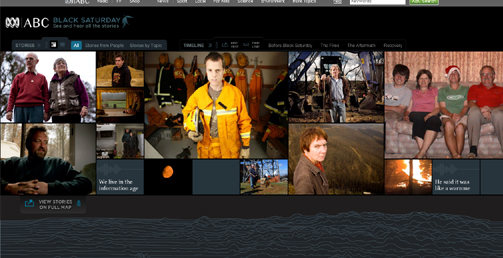Já são conhecidos os 12 projectos vencedores do Knight News Challenge. Aqui ficam os links:
1. The Cartoonist: To engage readers in the news, this project will create a free tool that produces cartoon-like current event games – the game equivalent of editorial cartoons. The simplified tools will be created with busy journalists and editors in mind, people who have the pulse of their community but don’t have a background in game development. By answering a series of questions about the major actors in a news event and making value judgments about their actions, The Cartoonist will automatically propose game rules and images. The games aim to help the sites draw readers and inspire them to explore the news.
2: Local Wiki: Based on the successful DavisWiki.org in Davis, Calif., this project will create enhanced tools for local wikis, a new form of media that makes it easy for people to learn – and share – their own unique community knowledge. Members will be able to post articles about anything they like, edit others and upload photos and files. This grant will help create the specialized open-source software that makes the wiki possible and help communities develop, launch and sustain local wiki projects.
3. CityTracking: To make municipal data easy to understand, CityTracking will allow users to create embeddable data visualizations that are appealing enough to spread virally and that are as easy to share as photos and videos. The dynamic interfaces will be appropriate to each data type, starting with crime and working through 311 calls for service, among others. The creators will use high design standards, making the visuals beautiful as well as useful
4. WindyCitizen’s Real Time Ads: As a way to help online startups become sustainable, this project will develop an improved software interface to help sites create and sell what are known as “real-time ads.” These ads are designed to be engaging as they constantly change – showing the latest message or post from the advertiser’s Twitter account, Facebook page or blog. Challenge winner Brad Flora helped pioneer the idea on his Chicago news site, WindyCitizen.com.
5. GoMap Riga: To inspire people to get involved in their community, this project will create a live, online map with local news and activities. GoMap Riga will pull some content from the Web and place it automatically on the map. Residents will be able to add their own news, pictures and videos while discussing what is happening around them. GoMap Riga will be integrated with the major existing social networks and allow civic participation through mobile technology. The project will be tested in Riga, Latvia, and ultimately be applicable in other cities.
6. Order in the Court 2.0: To foster greater access to the judicial process, this project will create a laboratory in a Boston courtroom to help establish best practices for digital coverage that can be replicated and adopted throughout the nation. While the legislative and executive branches have incorporated new technologies and social media, the courts still operate under the video and audio recording standards established in the 1970s and ’80s. The courtroom will have a designated area for live blogging via a Wi-Fi network and the ability to live-stream court proceedings to the public. Working in conjunction with the Massachusetts court system, the project will publish the daily docket on the Web and build a knowledge wiki for the public with common legal terms.
7. Front Porch Forum: To help residents connect with others and their community, this grant will help rebuild and enhance a successful community news site, expand it to more towns and release the software so other organizations, anywhere can use it. The Front Porch Forum, a virtual town hall space, helps residents share and discuss local news, build community and increase engagement. The site, currently serving 25 Vermont towns, will expand to 250.
8. One-Eight: Broadening the perspectives that surround U.S . military operations in Afghanistan, this project will chronicle a battalion by combining reporting from embedded journalists with user-generated content from the Marines themselves . The troops and their families will be key audiences for the online journal steering, challenging and augmenting the coverage with their feedback . The approach will directly serve the stakeholders and inform the wider public by bringing in on-the-ground views on military issues and the execution of U .S . foreign policy. The troops were recently authorized to use social media while deployed, and this project will also study the impact of that decision on the military.
9. Stroome: To simplify the production of news video, Stroome will create a virtual video-editing studio. There, correspondents, editors and producers will be able to upload and share content, edit and remix with friends and colleagues – all without using expensive satellite truck technology. The site will launch as eyewitness video – often captured by mobile phones or webcams – is becoming a key component of news coverage, generating demand for supporting tools
10.CitySeed: To inform and engage communities, CitySeed will be a mobile application that allows users to plant the “seed” of an idea and share it with others. For example, a person might come across a great spot for a community garden. At that moment, the person can use the CitySeed app to “geotag” the idea, which links it to an exact location. Others can look at the place-based ideas, debate and hopefully act on them. The project aims to increase the number of people informed about and engaged with their communities by breaking down community issues into bite-size settings.
11. PRX StoryMarket: Building on the software created by 2008 challenge winner Spot.us, this project will allow anyone to pitch and help pay to produce a story for a local public radio station. When the amount is raised (in small contributions), the station will hire a professional journalist to do the report. The project provides a new way for public radio stations to raise money, produce more local content and engage listeners.
12. Tilemapping: To inspire residents to learn about local issues, Tilemapping will help local media create hyper-local, data-filled maps for their websites and blogs. Journalists will be able to tell more textured stories, while residents will be able to draw connections to their physical communities in new ways. The tools will be tested in Washington, D.C. Ushahidi, a 2009 Knight News Challenge winner, used a prototype after the earthquake in Haiti to create maps used to crowdsource reports on places needing aid.


